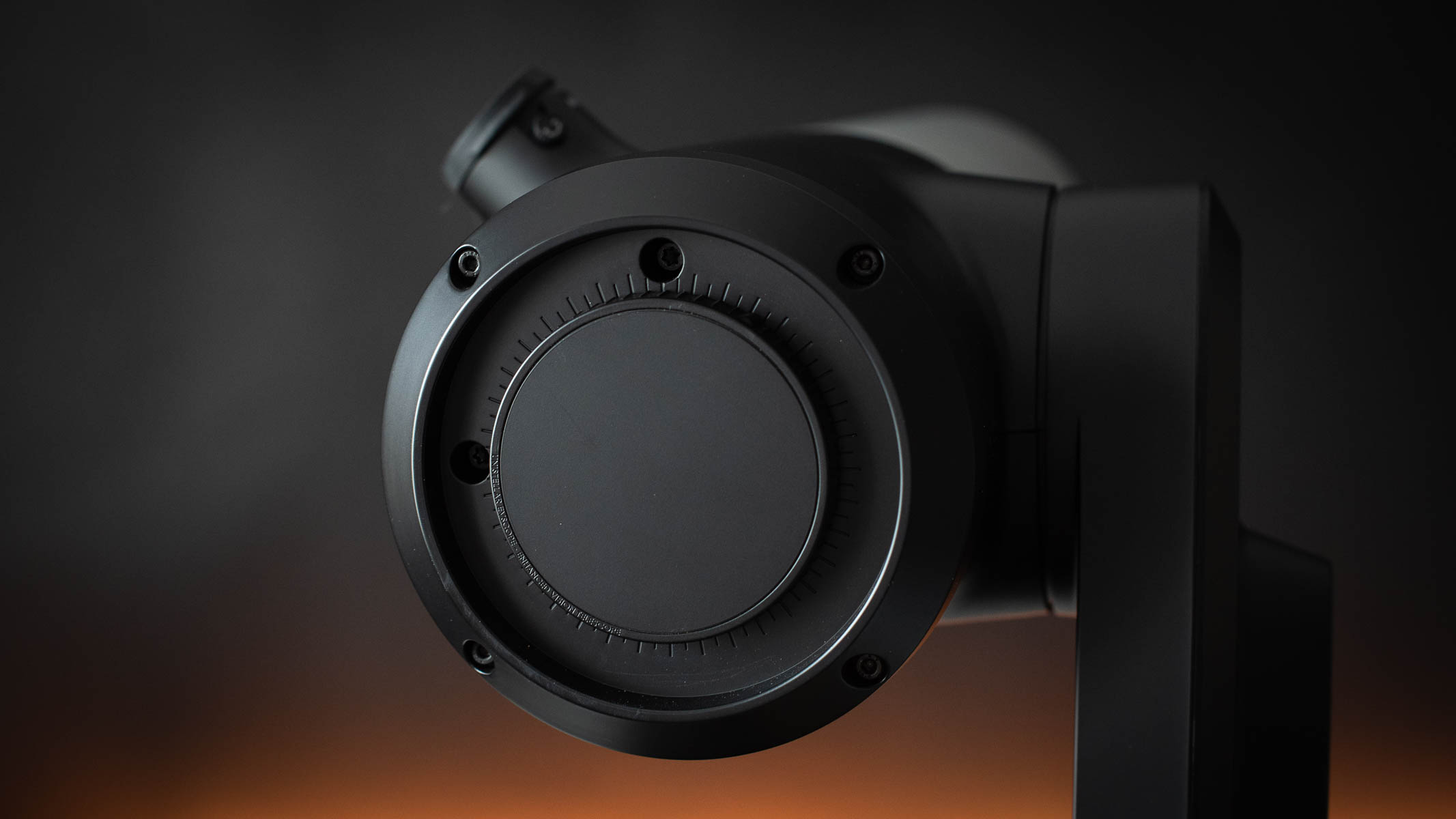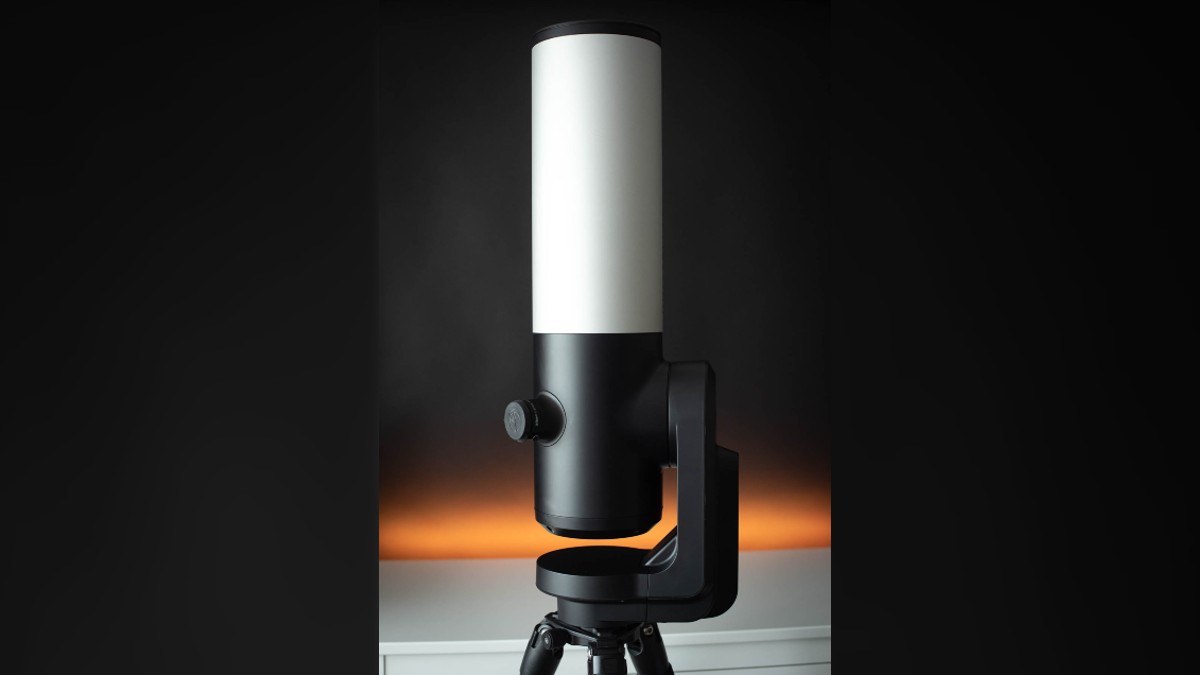Live Science Verdict
Unistellar has clearly gone over each tiny aspect of the eVscope 2’s design and every inch feels and looks premium. An all-encompassing system allows newcomer astronomers to navigate quickly to popular celestial objects and includes a 7.7MP camera built-in with intelligent enhanced imaging techniques to capture detailed images of the heavens. Though it has an electronic eyepiece, traditional astronomers may miss an optical eyepiece.
Pros
- +
Very easy to start using
- +
Absolutely beautiful design and premium construction
- +
Nikon-made electronic eyepiece
- +
User interface on app is simple and intuitive
Cons
- -
Priced too high for many new astronomers
- -
Veteran telescope users might miss optical eyepiece
Why you can trust Live Science
Optical design: Reflector
Aperture: 4.5-inches (114 mm)
Focal length: 17.7-inches (450 mm)
Focal ratio: f/3.9
Total kit weight: 19.8 lbs (9kg) including tripod
Mount type: Alt-azimuth
If you want to take a look into what the future of telescopes might be, look no further than the Unistellar eVscope 2. Gone is the complex dance of star alignment, aging hand controls, and complicated-looking construction and mounts. Housed in a sleek, minimalist tube and mount the eVscope 2 does it all.
It is the second iteration in the eVscope series and has some notable upgrades. A 4.5-inch (114mm) reflector, this telescope has a wide field of view making it ideal for larger deep-sky objects. In an attempt to improve the tactile relationship astronomers have with their rather digital and electronic telescope,
Unistellar has included an electronic eyepiece for those who like to get hands-on. Made by Nikon, the micro OLED is of premium quality and is touted as the best in its class, but all these high-end features soon stack up to a hefty price and so it’s not for the faint of heart.
We won't bury the lede on this - the Unistellar eVscope 2 is easily one of the best telescopes we've ever tested, but with prices starting at $4,899.00, it really is only for experienced, and wealthy astronomers.
Unistellar eVscope 2 telescope review: Design

- Unique, minimalist design good for all astronomers
- Easy to mount on a strong, stable tripod
- A single button on the telescope means users can’t go wrong
For a telescope, the eVscope 2 is truly a work of art. The matte gunmetal gray of the telescope tube is complemented by a matte black mount which is cased in strong plastic that doesn’t feel cheap. Once mounted on the incredibly sturdy tripod the matte black design continues. Two set screws hold the mount in place on the tripod which makes it a breeze to set up.
There is only a single button on the whole telescope but it has multiple important functions: on and off are its primary focus. The button also has an LED encircling it, giving it the ability to communicate its current state based on LED color and whether it’s steady or blinking.
Continuing this minimalist design the telescope has a lens cap with a hidden Bahtinov mask inside which can be released by unscrewing it from the main cap. The Nikon micro OLED electronic eyepiece is wonderfully contoured by the casing and the rubber surround is comfortable to use. One thing to note is that the rubber is prone to catching dirt and fibers, so remember to take a wipe with you if you’re worried about keeping it clean or if you have any allergies.
Get the world’s most fascinating discoveries delivered straight to your inbox.
It’s simple to mount: just extend the tripod legs and lock them off before placing the telescope and mount into the central slot. Secure it with the two thumb grip set screws. As it stands on the tripod the telescope reminds us of the Saturn V rocket on the launchpad, towering up above everything else except the very tallest people. A quick power on and synchronize with the app on a smart device, and the eVscope 2 sweeps into action easily controlled with the app. Almost everything by this point is controlled with the app and Unistellar has paid attention here, too.
Potential users thinking of buying this telescope should opt for the additional backpack that comes with bespoke housing for the telescope, accessories, and space for the tripod to be attached. It’s slender and makes carrying the telescope and tripod incredibly easy — opening up far-off locations only accessible by foot.
Unistellar eVscope 2 telescope review: Performance

- Large focus ring at rear of telescope
- Enhanced image building mode reveals more
- Manual telescope control via the app is speedy
As well as being simple in design, the eVscope 2 is simple to operate, even for rank amateurs. Thanks to sophisticated image analyzing and a fully motorized mount that communicates with the app, anyone can use the telescope to navigate to celestial objects in the night sky without having any prior knowledge of constellations or star positioning.
Because the telescope can only be operated via the smart device app it’s a good idea to make sure both the telescope and smart device (such as a phone) are charged before going on location. Once fully charged we found no problem using it in short bursts over several nights without issue.
When experimenting with telescope repositioning in the app we thought the movement was smooth and speedy, with the option of being more precise by backing off the drag-and-slide controls on-screen. It can even move diagonally which makes it faster to manually adjust positioning, rather than having to switch between X and Y axis movements simultaneously.
We found the live view option was optimal for locating subjects but the digital nature of the telescope meant that changing focus with the ring on the back of the eVscope 2 tube was quite tricky. There was a lag between focus adjustment and the live view updating which we found made it difficult to nail pinpoint focus during our tests. Fortunately, the Bahtinov mask came in useful for getting more precise focusing in this instance.
Stepping away from manual observing though is where the eVscope 2 excels. Using Explore mode the Unistellar app gives recommendations for viewing based on time, date, year and GPS location it sucks in through the internet. It’ll even tell you when to expect the next significant objects and which ones are fading out. For more advanced users it has an Advanced mode to customize telescope positioning with Go to RA/Dec and Go to Alt/Az options included.
The Enhance image view comes into its own by taking a longer exposure of objects and, while tracking, it reveals many more stars than can otherwise be seen with the naked eye. Even in the middle of a city the eVscope 2 is capable of revealing hidden stars in the night sky only usually visible when in very dark sky locations.
Unistellar eVscope 2 telescope review: Functionality

- Quick automatic navigation to night sky objects
- Easy to set up and carry
- Some may miss an optical eyepiece for stargazing
The eVscope 2’s biggest benefits are also some of its weaknesses. Due to the all-digital design, the Nikon micro OLED eyepiece can help you see better in the dark compared with optical eyepieces, which is most noticeable when vision hasn’t yet adjusted to the night. The same goes for the in-built camera which can image straight from the Unistellar app. It even saves helpful information on the photos recording time, date and location. However, for some, this digital divide can distance them from their stargazing experience.
While probably physically impossible to design this telescope with an optical eyepiece, we did miss the opportunity to get more hands-on and feel that astronomers that have been using traditional refractors, reflectors or catadioptric telescopes for many years will miss this tactile aspect of night sky observing. But for the uninitiated that perhaps have little to compare to, or experienced astronomers that don’t have the time to set up, collimate, and align telescopes for astronomy, the eVscope 2 swoops in and saves everyone time (but certainly not money).
Should I buy the eVscope 2?

The initial financial outlay for the Unistellar eVscope 2 is a significant one, and if you want to get the additional telescope backpack (we recommend you do) as well it’ll take another little chunk out of your bank balance. However, because of its design, there are no other ongoing costs because you can’t change things like eyepieces or add Barlow lenses.
If what you’re looking for is a telescope that can be used by anyone in the household to view and take photographs of the night sky with relative ease, and one that does so by looking stunningly beautiful at the same time, then the eVscope 2 is for you.
Who this telescope might not be for though, is astronomers who want to change mounts, add Barlow lenses, have the flexibility to swap out eyepieces and further accessorize their telescope. It’s also not great for anyone on a budget. If you can afford it and you want something quick to set up, fast to navigate to your favorite celestial objects and take a few photographs in the meantime, then the eVscope 2 is perfect.
If this product isn’t for you
Despite its all-around appeal to both experienced astronomers and newcomers, the price and digitization might put some off. In this case, we’d recommend the excellent Celestron NexStar 8SE. A fraction of the price of the eVscope 2 (though still not cheap) it offers clear, bright views of the cosmos and still comes with all the computerized and motorized ability the eVscope has to offer. Enhance it further with Barlow lenses and different eyepieces, even a camera adapter, and this telescope is perfect for intermediate users that want the flexibility to customize their scopes.
However, beginners might want to take heed of the Celestron StarSense Explorer DX 130AZ which is significantly less expensive and also connects up to a smart device for quick observing, however, as you’d expect for this price, it’s a push-to mount meaning you have to get more hands-on.

Jase Parnell-Brookes is the Managing Editor for e-commerce for Live Science and Space. Previously the Channel Editor for Cameras and Skywatching at Space, Jase has been an editor and contributing expert across a wide range of publications since 2010. Based in the UK, they are also an award-winning photographer and educator winning the Gold Prize award in the Nikon Photo Contest 2018/19 and named Digital Photographer of the Year in 2014. After completing their Master's degree in 2011 and qualifying as a teacher in 2012, Jase has spent the last two decades studying and working in photography and publishing in multiple areas, and specializes in low light optics and camera systems.

